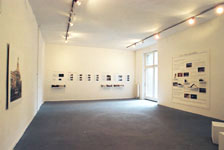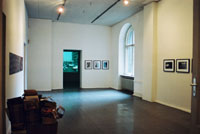
artists |
Exhibition |
 |
 |
Cairoscape or a journey into Cairo
A project curated by Marina Sorbello und Antje Weitzel
For centuries Cairo has been the cultural capital of Arabic-speaking countries, originating most of their important literature, songs and, more recently, films."He who has not seen Cairo has not seen the world," asserts a character in One Thousand and One Nights. "Its dust is gold; its Nile is a wonder; its houses are palaces; its air is temperate; its odour surpassing that of aloe wood and cheering the heart." This poetic description provides quite a contrast to present-day Cairo, dirty, suffocatingly hot, overcrowded and hugely polluted as it is. Yet Cairo, with its extreme density and intensity, and its idiosyncrasies, continues to be a source of enchantment and fascination for travellers and for its inhabitants.
Cairoscape – Images, Imagination and Imaginary of a Contemporary Mega City takes us on a journey into and within today’s Cairo as seen through the works of the eighteen participating artists. The artists either come from Egypt or have recently completed residencies in the country. In their works they reflect a certain contemporary and existential urban condition connected to the city of Cairo, its suggestive power and collective imaginary, its appearance and its unconscious, and the histories and dreams of its inhabitants. Imagination, wild associations, non-linear narratives and an adventurous mix of fact and fiction are distinctive features of the approach of artists such as Sherif El Azma (Cairo), Shady El Noshokaty (Cairo), Katarina Šević (Budapest), Iman Issa (Cairo/New York) and Hala Elkoussy (Cairo/Amsterdam). In their works, dreams, visions, poetry and histories overlap in suggestive, poetic ensembles where the city emerges transfigured and reinvented. Elkoussy’s film We’re By The Sea Now (2006) is structured in thirteen episodes of seemingly disparate anecdotal events, personal accounts, tales and hearsay. For the artist, “What appear to be banal actions, obvious choices and clear directions mandated by everyday necessities, unveil more central questions: How can and is the topography of a megalopolis navigated? How does one mark its permeable history? And most crucially, how does one negotiate a position within the masses, under the overbearing pressures of consumerism, social norms and political apathy?”
Remarkable inventiveness and great ability to constantly adapt to changing living conditions shape the relationship of the Cairenes with their environment. Rana El Nemr (Cairo) and Maha Maamoun (Cairo), in their photo series present unusual and unexpected points of view on prosaic details of the cityscape. Maamoun looks for an idea of, or surrogate of nature in the city, and finds it in the colourful dresses and veils of the women of Cairo; El Nemr reassembles photographs of painted balconies taken in the vernacular districts and in the informal housing areas of Cairo into imaginative collages of residential blocks.
The layered histories embedded in the city of Cairo are themes in works by Susanne Kriemann (Rotterdam/Berlin) and Hermann Huber (Vienna), who during residencies in Cairo did research on its architecture and urban space. Kriemann shows the transformations of the megalopolis through a collection of archival images of the pharaonic statue of Ramses II and its surroundings. In the Nasser era the statue symbolized the roots of the Egyptian nation and was set in front of Cairo’s central station where it stayed until, in 2006, it was moved due to preservation issues. Hermann Huber films an abandoned, decaying colonial department store in the middle of Cairo, that is filled nowadays with small sweatshops. Huber’s tableau vivant is a psychological portrait of a building, and shows another side of contemporary globalization.
Cairo, like all third world metropolises, is primarily a city of migrants from the countryside, and to them it shows a very different face of modernity: anonymity, great opportunities and new horizons, but also alienation and a prohibitively high cost of living. With its estimated 15 to 25 million inhabitants, the Egyptian capital is the largest metropolis of the Middle East and Africa and ranks as one of the world’s largest cities, and probably the most densely populated with an average of 70,000 persons per square mile. The informal housing areas in the peripheries of Cairo (ashway’iyat, literally: random), large red-brick agglomerates built according to no plan, where the poor live in often appalling conditions, are home to an estimated five million people scattered throughout more than one hundred informal communities. In her installation Nermine El Ansari (Cairo) juxtaposes paintings inspired by these informal agglomerates in Cairo’s surroundings with paintings of concrete buildings in commercial districts. Informal communities are even populating the rooftops of the central districts of Cairo. The invisible rooftop dwellers are the protagonists of the black and white photo series Under the Same Sky: Rooftops of Cairo (2002-2003) by Randa Shaath (Cairo). Doa Aly (Cairo) looks into another almost invisible community in the Egyptian capital: that of Chinese female immigrants who work in Egypt on tourist visas, selling cheap clothing (made in China) door-to-door.
Themes of transformation, density and the urban condition inform works by Khaled Hafez (Cairo), Christoph Oertli (Basel/Brussels), and Hany Rashed (Cairo), each using different media. Hafez’ aerial cityscapes freeze a surreal Cairo during extreme light conditions at dusk and dawn. In his film Cairo, Oertli empties the city of its crowds, leaving the protagonist to drift completely alone through the deserted city: a most unlikely situation in present-day Cairo. Rashed on the other hand, playfully fills the exhibition space with a crowd of small sculptures portraying urban life and the varied population of Cairo’s public spaces.
Street sellers and workers, car horns, calls to prayers, coffee shop conversations, whistles, recorded music, mobile phones, car alarms, stray dogs and wild bird colonies: for sound artist Gilles Aubry (Berlin) the Cairo soundscape is a sleepless conversation. His immersive sound installation for Cairoscape provides visitors to the exhibition with an acoustic journey through the mega city. Travelling, and the difficulty for Egyptians to travel abroad due to restrictive western visa policies, are addressed by Aubry as well as by Maia Gusberti (Vienna). Gusberti’s series of photographs Travel.agencies is a project about visual representations of travelling based on the aesthetics of travel agencies in downtown Cairo, where foreign places are not represented by images but by aged world maps, leaving it to the occasional clientele to imagine their destinations. Foreign travelling, or going abroad to find work and better living conditions, is a mirage to most young Egyptians. According to statistics, 80% of youngsters under twenty-five (i.e. 65% of the entire Egyptian population) want to go to the West, but obtaining necessary visas to leave the country is very difficult.
Social issues, particularly the question of male identity in contemporary Egyptian society, are central to Cairo-based Ahmed Khaled’s experimental film production. His latest film, Fish Eye, offers a subtle and contradictory perspective on urban life in Cairo as seen from the viewpoint of an unemployed, middle-class Egyptian man in his thirties, who suffers from insomnia. As unemployment is endemic in Cairo, the nameless protagonist of the film embodies an entire generation of young people without jobs and without prospects. Ahmed Khaled displays in a surreal and rather ruthless way the position of the marooned Egyptian man in a modern, impersonal society. The question suspended throughout the film is: With such a life, does it really matter whether he sleeps or not? (text: Marina Sorbello)
Exhibition Venue
Kunstraum Kreuzberg/Bethanien
Mariannenplatz 2, 10997 Berlin
0049 (0)30 90298-1455
U1/U8 Kottbusser Tor
Opening hours
Daily: 12:00 - 19:00
Thursdays: 12:00 - 22:00
Guided tours on request